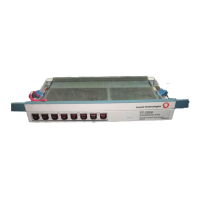Maintenance Description
9-10 Issue 8.0 July 2002
*If the TRMTR, RCVR, or REGENR slots are in the EQ state, the associated incoming OC-48 signals
are also monitored and alarmed.
† If the low-speed interface slots are in the EQ state, the incoming low-speed signals are monitored and
alarmed.
‡ Available in Release 5 and later releases.
§ If the low-speed interface slots are in the EQ state and the associated low-speed ports are in the IS
state, the incoming low-speed signals are monitored and alarmed.
¶ Available in Release 4.1 and later releases.
** If a DS1 input port is in the IS state, the associated incoming DS1 synchronization reference signal is
monitored and alarmed when a failure occurs.
†† Available in Release 6 and later releases.
*† Available in Release 7.1.0 and later releases.
The indicators that are subject to incoming signal alarm delay are:
■ Audible and visible office alarm outputs
■ Parallel telemetry outputs
■ Serial telemetry (TBOS) alarm and scan points (Release 4.1 and later)
■ TL1 autonomous messages
*
■ Critical (CR), major (MJ), and minor (MN) LEDs on the user panel
■ Status field in the upper left hand corner of the CIT screen.
The indicators that are
not
subject to incoming signal alarm delay are:
■ FAULT LEDs on the circuit packs
■ All CIT reports
EC-1§¶ Alarm Indication Signals (AIS) (from STSX)
Line RFI/Yellow (from STSX)
Loss of Frame (LOF) (from STSX)
Loss of Pointer (LOP) (from STSX)
Loss of Signal (LOS) (from STSX)
Path Integrity Failure‡
Signal Degrade (SD) (from STSX)
STS Loss of Pointer (LOP) (from OC-48)
STS Loss of Pointer (LOP (from STSX
DS1** DS1 Reference Failure
* TL1 autonomous messages for alarm and status conditions are only available on X.25
virtual circuits when the value of the OS Type parameter is provisioned “maintenance” or “other” using
the SECURITY-Set-Security-Port input.
Table 9-1. Incoming Signals and Monitored Conditions (Contd)
Incoming Signal Level Monitored Conditions

